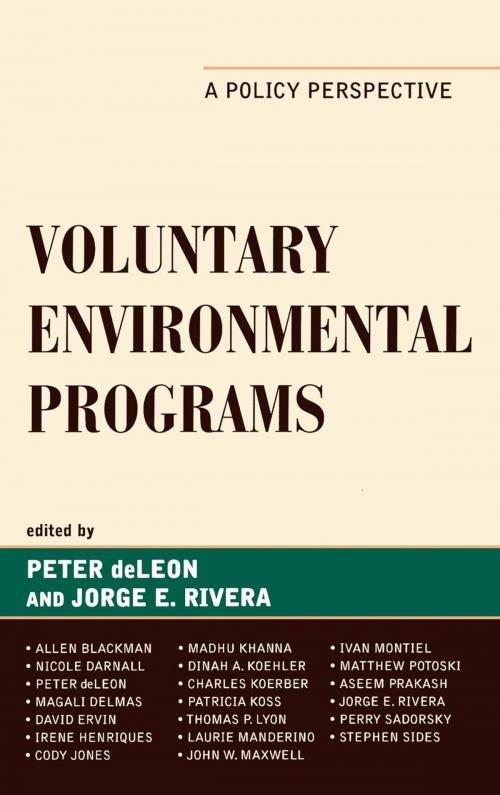Voluntary Environmental Programs
A Policy Perspective
Nonfiction, Social & Cultural Studies, Political Science, Government, Public Affairs & Administration, Public Policy| Author: | Allen Blackman, Aseem Prakash, Charles Koerber, Cody Jones, , Darnell, David Ervin, Dinah A. Koehler, Irene Henriques, Ivan Montiel, John W. Maxwell, Jorge Riviera, Laurie Manderino, Madhu Khanna, Magali Delmas, Matthew Potoski, Patricia Koss, Perry Sadorsky, Peter de Leon, Thomas P. Lyon, , Sides | ISBN: | 9780739133248 |
| Publisher: | Lexington Books | Publication: | December 3, 2009 |
| Imprint: | Lexington Books | Language: | English |
| Author: | Allen Blackman, Aseem Prakash, Charles Koerber, Cody Jones, , Darnell, David Ervin, Dinah A. Koehler, Irene Henriques, Ivan Montiel, John W. Maxwell, Jorge Riviera, Laurie Manderino, Madhu Khanna, Magali Delmas, Matthew Potoski, Patricia Koss, Perry Sadorsky, Peter de Leon, Thomas P. Lyon, , Sides |
| ISBN: | 9780739133248 |
| Publisher: | Lexington Books |
| Publication: | December 3, 2009 |
| Imprint: | Lexington Books |
| Language: | English |
Protecting the environment is often not the primary objective of businesses. As the world has become more environmentally aware, the necessity of environmental regulations becomes apparent. Voluntary Environmental Programs: A Policy Perspective examines different approaches to environmental protection in business. Environmental improvements on the part of industry often result from government regulations that command certain action on the part of industry and then control how well they perform. An alternative approach is Voluntary Environmental Agreements (VEA), where firms voluntarily commit to make certain environmental improvements individually, as part of an industry association, or under the guidance of a government entity. For example, many new initiatives targeted towards climate change originate from companies that voluntarily commit to reduce their carbon output or 'footprint.' Voluntary Environmental Programs (VEP) provides an overview of current research on VEPs, looking at issues such as what motivates firms to participate, how a VEP structure affects a company's efficiency and credibility with stakeholders, and who monitors compliance of participants. This current work examines how a firm's environmental performance over time compares with VEP commitments. This book also discusses the particular considerations for VEPs in developing countries, where information flows and regulatory oversight capacities differ from the U.S.
Protecting the environment is often not the primary objective of businesses. As the world has become more environmentally aware, the necessity of environmental regulations becomes apparent. Voluntary Environmental Programs: A Policy Perspective examines different approaches to environmental protection in business. Environmental improvements on the part of industry often result from government regulations that command certain action on the part of industry and then control how well they perform. An alternative approach is Voluntary Environmental Agreements (VEA), where firms voluntarily commit to make certain environmental improvements individually, as part of an industry association, or under the guidance of a government entity. For example, many new initiatives targeted towards climate change originate from companies that voluntarily commit to reduce their carbon output or 'footprint.' Voluntary Environmental Programs (VEP) provides an overview of current research on VEPs, looking at issues such as what motivates firms to participate, how a VEP structure affects a company's efficiency and credibility with stakeholders, and who monitors compliance of participants. This current work examines how a firm's environmental performance over time compares with VEP commitments. This book also discusses the particular considerations for VEPs in developing countries, where information flows and regulatory oversight capacities differ from the U.S.















